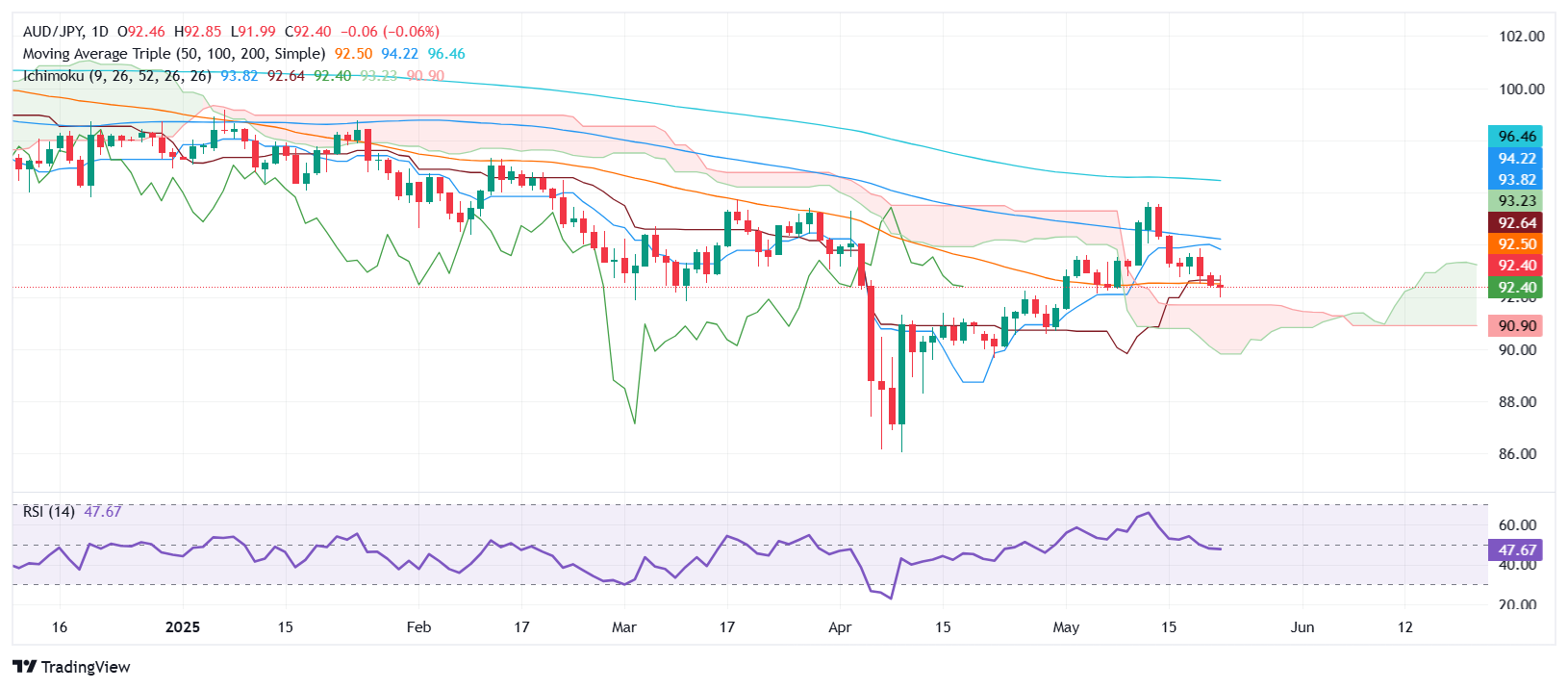AUD/JPY Price Forecast: Extends drop below 93.00 despite risk-on mood
- AUD/JPY down 0.15%, trading near 92.28 after hitting intraday high at 92.83.
- Despite weak momentum, pair holds above Ichimoku Cloud, signaling possible base.
- Bulls need break above 92.83 for upside; key support lies at 91.70/80 zone.
The Australian Dollar (AUD) continues to lose ground versus the Japanese Yen (JPY) late on Thursday, depreciating over 0.15% amid a risk-on mood. The Reserve Bank of Australia's (RBA) decision to cut rates earlier in the week continued to weigh on the Aussie Dollar, which is failing to find its form. The AUD/JPY trades at 92.28 after hitting a daily high of 92.83.
AUD/JPY Price Forecast: Technical outlook
After hitting a weekly high of 93.83, the AUD/JPY fell for three consecutive days, grinding lower amid anemic trading ranges of an average of 50 pips daily. Nevertheless, traders failed to push the pair below the Ichimoku Cloud (Kumo), suggesting a bottom could lie ahead.
For a bullish continuation, the AUD/JPY needs to clear the May 21 high at 92.83. A breach of the latter will expose 93.00, followed by the Tenkan-sen at 93.81. Once surpassed, the next stop would be 94.00.
On the flip side, AUD/JPY needs to drop below the top of the Kumo at 91.70/80. Once that area is cleared, the next support would be the Senkou Span B at 90.88.
AUD/JPY Price Chart – Daily

Australian Dollar FAQs
One of the most significant factors for the Australian Dollar (AUD) is the level of interest rates set by the Reserve Bank of Australia (RBA). Because Australia is a resource-rich country another key driver is the price of its biggest export, Iron Ore. The health of the Chinese economy, its largest trading partner, is a factor, as well as inflation in Australia, its growth rate and Trade Balance. Market sentiment – whether investors are taking on more risky assets (risk-on) or seeking safe-havens (risk-off) – is also a factor, with risk-on positive for AUD.
The Reserve Bank of Australia (RBA) influences the Australian Dollar (AUD) by setting the level of interest rates that Australian banks can lend to each other. This influences the level of interest rates in the economy as a whole. The main goal of the RBA is to maintain a stable inflation rate of 2-3% by adjusting interest rates up or down. Relatively high interest rates compared to other major central banks support the AUD, and the opposite for relatively low. The RBA can also use quantitative easing and tightening to influence credit conditions, with the former AUD-negative and the latter AUD-positive.
China is Australia’s largest trading partner so the health of the Chinese economy is a major influence on the value of the Australian Dollar (AUD). When the Chinese economy is doing well it purchases more raw materials, goods and services from Australia, lifting demand for the AUD, and pushing up its value. The opposite is the case when the Chinese economy is not growing as fast as expected. Positive or negative surprises in Chinese growth data, therefore, often have a direct impact on the Australian Dollar and its pairs.
Iron Ore is Australia’s largest export, accounting for $118 billion a year according to data from 2021, with China as its primary destination. The price of Iron Ore, therefore, can be a driver of the Australian Dollar. Generally, if the price of Iron Ore rises, AUD also goes up, as aggregate demand for the currency increases. The opposite is the case if the price of Iron Ore falls. Higher Iron Ore prices also tend to result in a greater likelihood of a positive Trade Balance for Australia, which is also positive of the AUD.
The Trade Balance, which is the difference between what a country earns from its exports versus what it pays for its imports, is another factor that can influence the value of the Australian Dollar. If Australia produces highly sought after exports, then its currency will gain in value purely from the surplus demand created from foreign buyers seeking to purchase its exports versus what it spends to purchase imports. Therefore, a positive net Trade Balance strengthens the AUD, with the opposite effect if the Trade Balance is negative.

